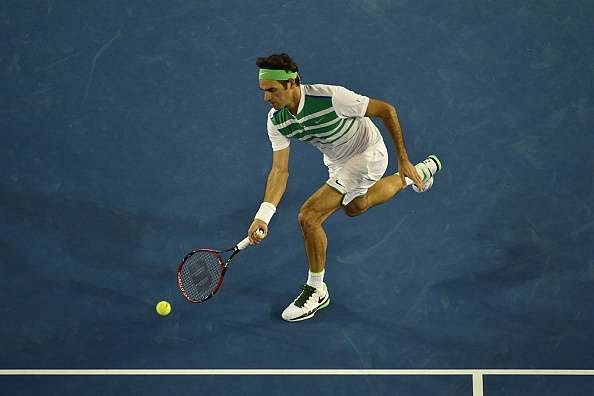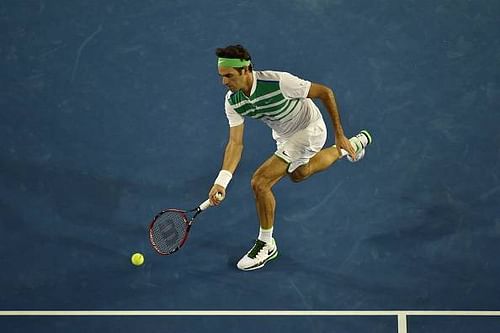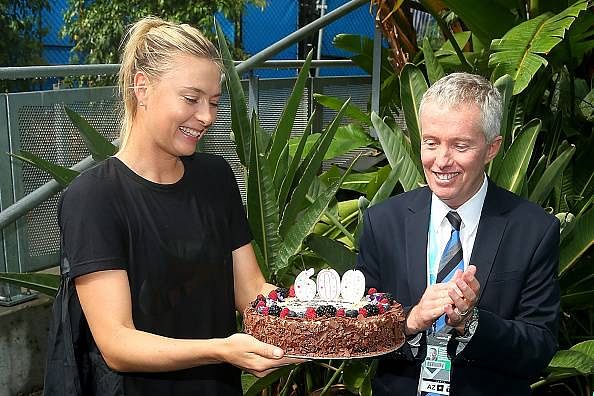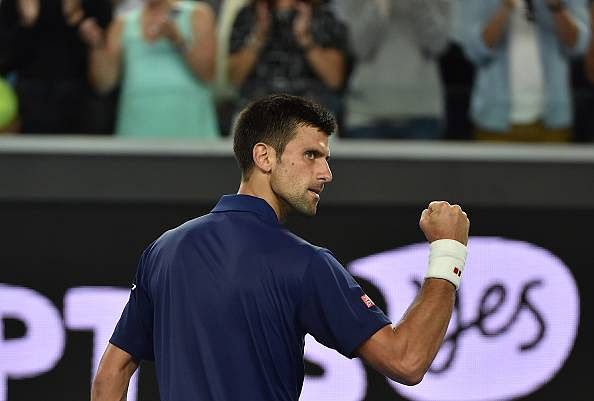
Australian Open diary: Learning something new from Federer, Djokovic and Sharapova
We can watch the pros strut their stuff on the court a million times, but in every match they still manage to show us something new – if we're willing to look for it. And it goes without saying that the 'discovery’ effect is magnified if you're watching from the stands rather than on TV.
As I spent my first day in Melbourne Park jumping from one court to another, I couldn't help but notice several new aspects about the games of Roger Federer, Novak Djokovic and Maria Sharapova, who were all in action on Day 5 of the 2016 Australian Open. Here's looking back at everything I learned from the day's play:
Federer has a break point problem, which may not have a solution

Roger Federer scooping out a forehand in his match against Grigor Dimitrov
One of Federer's biggest obstacles in recent years has been his poor break point conversion rate. The problem peaked in the most painful way possible at last year's US Open, where the Swiss went a ludicrous 4 on 23 against Djokovic.
Today Federer won four out of 15 against Grigor Dimitrov as he became the first man in the Open Era to register 300 Grand Slam match wins. While that's not as ghastly a conversion rate as the US Open final one, it is still well below par. And when you watch from afar, it's easy to think that he loses the break points because he lowers his intensity or gets nervous or in some way fails to play his natural game in the big moments.
But from the stands, none of that seems to hold good. Federer plays the break points almost exactly the same way as he does the other points – or at least he did so today. He's just as intense, just as aggressive, and also just as error-prone as he normally is.
It's a combination of the opponent's good play, and a bit of pressing on his own part (which he does on most neutral points too – just count the number of backhands he dumps into the net because he take the ball too early) that makes him seemingly 'squander’ the opportunities.
“It would be helpful, you know,” Federer said, when asked if improving his break point conversation was the key area he'd like to improve in. “You'd obviously want to win more break points when you have them. Sometimes, you know, they serve an ace, sometimes it just happens that it doesn't work out very well for you.”
We know it hasn't been working out very well for Federer lately when it comes to break point conversion. But there may not be all that much he can do about it.
Sharapova's game is both precise and unreliable; but is that her biggest strength?

Maria Sharapova is all smiles as she is presented with a cake to celebrate her 600th career win, by Australian Open tournament director Craig Tiley
I've written in the past that Sharapova is a study in contradictions. Today, as she notched up the 600th win of her career, I noticed the contradictions in her game again – but this time, it was easier to understand how she makes it all work.
Her serve is famously unreliable, and ever since Elena Dementieva's retirement Sharapova has been labelled the resident Double Fault Queen of the WTA. But when you watch her play you realize that her serve is shaky because it can be so good.
Sharapova never rolls her second serve in; she almost always goes after it, aiming for the lines while putting a fair bit of pace on the ball. But that's not something that anybody can do; if you aim for the line, you have to be precise with your technique and swing to make the ball fall in.
That, right there, is the Russian's greatest strength. She may be slow and awkward with her footwork, and she doesn't have the greatest touch at the net, but when it comes to precision serving and shot-making, she is second to no one (except, of course, Serena Williams; everyone is second to her).
Every time Sharapova was asked to hit a second serve against Lauren Davis today, she made sure she put plenty of juice on it, which meant that Davis always started the point on the backfoot. That also meant Sharapova hit a fair few doubles – there were five in total – but the trade-off was in her favour. She hit at least two second serve aces as per my count, and on a lot of other occasions she used the second delivery to bail her out of trouble.
Her forehand has a similarly adventurous quality. When I watched her play on TV all these years, I never noticed just how much risk she takes with the shot. Today, I saw her forehand come dangerously close to the line time after time, but more often than not it landed in. The trade-off, again, worked for her – while her winner-to-error differential was just +2 for the day, the number of points she won by putting the ball just that little bit further away from Davis was substantial.
Sharapova always goes all-in, whether it's on her serve, her forehand or even her swing volleys. And that's a good thing, because she's got the technique to back it up.
Djokovic plays to the crowd...in his own unique way

Novak Djokovic putting his intensity on full display in his match against Andreas Seppi
Djokovic was not on Rod Laver Arena today, but he may not have minded playing on the recently-refurbished Margaret Court Arena, which is almost as big and boisterous as RLA. His game, however, told a different story; after blazing through the opening set in just 25 minutes, he produced a string of uncharacteristic errors in the second and third to keep his opponent Andreas Seppi interested.
By the end of the third set, the crowd was cheering vociferously for the Italian, either because they wanted a longer match or because they just liked him – I couldn't really tell. Predictably, that set Djokovic off on one of his tirades, as he started muttering furiously to himself after every shot he missed.
This wasn't exactly a case of the crowd hating on Djokovic. But the Serb seems to have made it a habit of feeding off the crowd's energy – whether positive or negative or real or imagined – to ramp up his own game. He still struggled to keep the errors at bay, but you could see that he was more invested in the match now, and that he wanted to end it with a statement.
Seppi went up two set points at 6-4 in the third set tiebreaker, and the noise in the arena reached a crescendo. But Djokovic duly saved the first by outhitting Seppi from the baseline, which meant the Italian had just one more set point left – this time on his own serve.
He then missed his first serve, and a collective groan went around the stands. Everyone watching knew the importance of getting the first serve in on that point; with a raging Djokovic on the other side of the net, there could be no coming back from there.
Right on cue, Djokovic saved the second set point too, before winning the next two points to seal the set and the match. And just in case we had our doubts, he let everyone know how badly he wanted to win by doing a series of angry fist-pumps and leaping into the air as if he wanted to fly into the stands and start cheering for himself.
Djokovic may not always have the strongest crowd support, but I doubt there's ever been a player who uses the crowd as effectively as the World No. 1. If you cheer for him, he'll ride the wave of positive emotion and put in a dominating performance. But if you cheer for his opponent, he'll bring out his defiant side and go into refuse-to-lose mode, which is a pretty daunting opponent to play against too.
And oh, even with all his errors, Djokovic was still the second best singles player on show today (behind Serena Williams, who was so good today that her match got over in the time it took Federer and Dimitrov to finish their press conferences). It's just that the Serb has been so incredibly good these last few years, that nothing but perfection seems acceptable from him.
That's not a bad place to be in for the five-time champion.